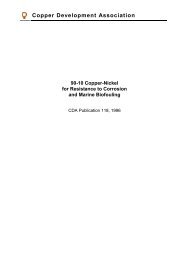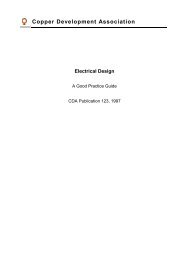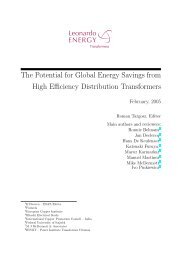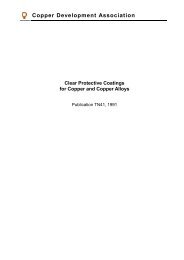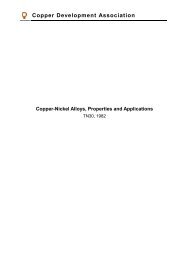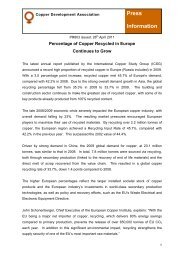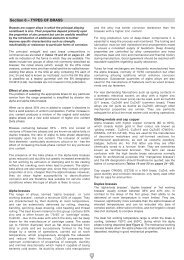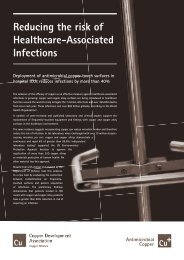Selecting Energy Efficient Distribution Transformers - Copper ...
Selecting Energy Efficient Distribution Transformers - Copper ...
Selecting Energy Efficient Distribution Transformers - Copper ...
- No tags were found...
Create successful ePaper yourself
Turn your PDF publications into a flip-book with our unique Google optimized e-Paper software.
<strong>Selecting</strong> <strong>Energy</strong> <strong>Efficient</strong> <strong>Distribution</strong> <strong>Transformers</strong>A Guide for Achieving Least-Cost SolutionsPROJECT Nº EIE/05/056/SI2.419632First Published June 2008Prepared for Intelligent <strong>Energy</strong> Europe ProgrammeStrategies for Development and Diffusion of<strong>Energy</strong> <strong>Efficient</strong> <strong>Distribution</strong> <strong>Transformers</strong>byPolish <strong>Copper</strong> Promotion Centre and European <strong>Copper</strong> Institutein collaboration withNational Technical University of Athens, NTUA -SEEDT Co-ordinatorAgence De l’ Environnement et de la Maitrise de l’ Energie, ADEMEAlternatives pour l’énergie, les énergies renouvelables et l’environnement, AEREAREVA T&D Spółka z ograniczoną odpowiedzialnością, AREVAENDESA Distribución Electrica, ENDESAFederazione delle Associazioni Scientifiche e Techniche, FASTŁódzki Zakład Energetyczny S.A., ŁZE S.A.Thelcon LtdWuppertal Institut für Umwelt, Klima, Energie GmbHGreeceFranceFrancePolandSpainItalyPolandGreeceGermanywith the support of the EUROPEAN COMMISSION
This SEEDT Guide is Something Good for You:If …… you would like to: purchase a distribution transformer at the least lifecycle costs achieve further energy and budget savings in your organisation contribute to increasing energy security and reducinggreenhouse gas emissions …… and you are: working in an electricity distribution company, industry,commercial or public organisation wanting to purchase adistribution transformer working as a facility manager, planner or equipment installerin charge of technical planning or preparing the purchase of adistribution transformer in a client’s organisation …… then we recommend you to read this brochure.It presents recommendations and results of the European projectSEEDT (Strategies for development and diffusion of energy-efficientdistribution transformers), carried out with financial support from theEUROPEAN COMMISSION under the Intelligent <strong>Energy</strong> – Europe programmeand national co-financiers. The aim of SEEDT is to promote the use ofenergy-efficient distribution transformers, which can be profitable forinvestors, and by contributing to European Community energy savings,may help to fulfil EU energy policy targets.DisclaimerThe sole responsibility for the content of this publication lies with theauthors. It does not necessarily reflect the opinion of the EuropeanCommunities. The European Commission is not responsible for any use thatmay be made of the information contained therein. While this documenthas been prepared with care, SEEDT team and any other contributinginstitutions give no warranty in regards to the contents and shall not beliable for any direct, incidental or consequential damages arising out of its use.
Contents1 INTRODUCTION 71.1 Profitable Solutions Contributing to European Targets 71.2 European <strong>Distribution</strong> Transformer Characteristics 72 Losses in transformers 92.1 Definition of transformer losses 92.1.1 Extra losses due to harmonics 102.2 Losses in European <strong>Distribution</strong> <strong>Transformers</strong> 112.3 Transformer losses standards 133 Cost of losses 153.1 Annual energy losses and cost of these losses 153.2 Life cycle cost of transformers 153.3 Price of a transformer 173.4 Electricity price 183.5 Time value of money – interest rate 193.6 Lifetime 193.7 Loading profile and Load factor 193.8 Other aspects; technical (cos phi, harmonics), operational andenvironmental (climate change mitigation, ecodesign) 213.9 Sensitivity analysis 214 <strong>Energy</strong>-efficient transformers 234.1 Traditional technologies 234.2 Superconducting transformers 234.3 Amorphous transformers 235 Policy support proposed by SEEDT 256 Conclusions 277 Bibliography 28Annex 295
LIST OF FIGURESFigure 1. <strong>Distribution</strong> transformer population / rated power 8Figure 2. Fire of a pole-mounted distribution transformer in the streetsof Moscow 10Figure 3. Breakdown of distribution sector distribution transformer losses,EU-27 and Norway 12Figure 4. Operating efficiency of distribution sector distribution transformers,EU-27 and Norway 12Figure 5. Simplified chart for calculation of factor A 16Figure 6. Explanation of relation between time of peak lossesand time of peak load 20Figure 7. Sensitivity analysis – capitalised cost 21Figure 8. Continuously transposed conductors (courtesy DKI) 22Figure 9. Casting amorphous metal – Courtesy Metglas, Inc 24Figure 10. Amorphous transformer from the inside 24Figure 11. <strong>Energy</strong>-efficient transformers can help our environment. 25LIST OF TABLESTable 1: EU27 distribution transformer populations and annual market(transformers installed in 2004) 8Table 2: EU-27 distribution transformer losses 11Table A.1 HD428/HD538 29Table A.2 EN 50464-1No-load losses P (W) and sound power level (Lw )for U≤24 kV 29Table A.3 EN 50464-1 Load losses Pk (W) at 75 °C for Um ≤ 24 kV 30Table A.4 EN 50464-1Load losses Pk36 (W) at 75 °C for Um = 36 kV 30Table A.5 EN 50464-1No-load losses P036 (W) and sound power level (Lw (A) )for Um = 36 kV 30LIST OF ILLUSTRATIONSPhotography used under the terms of the GNU Free Documentation license version 1.2:••Title page photo: Transformer building in Eizer (Overijse), Belgium - author Wouter Hagens.••Page 27 top photo: Transformer in Wroclaw, Poland - author Kamil Kozłowski.••Page 27 bottom photo: Three-Phase, Medium-Voltage Transformer - author Stahlkocher.6
1 INTRODUCTION1.1Profitable SolutionsContributing to EuropeanTargetsSEEDT – Strategies for development and diffusionof <strong>Energy</strong>-efficient <strong>Distribution</strong> <strong>Transformers</strong> - isone of the projects in the Intelligent <strong>Energy</strong> Europeprogramme.The aim of this project is to promote the use ofenergy-efficient distribution transformers, whichcan be profitable for investors, and, by contributingto European Community energy savings, mayhelp to fulfil EU energy policy targets. Strategiesdeveloped in SEEDT include proposals for changesto the regulatory scheme for electricity distributioncompanies, labelling, mandatory standards, furthersupport mechanisms, and dissemination activities.<strong>Energy</strong> efficiency has now become the top priorityfor European energy policy. The Action Plan on<strong>Energy</strong> Efficiency, released in 2006 by the EuropeanCommission, envisaged launching a debate onhow the EU could achieve a reduction in its energyconsumption by 20% (390 Mtoe) compared to the‘business as usual’ projections for 2020 on a costeffectivebasis and, by so doing, limit the growth inenergy consumption to a level below 1500 Mtoe/yearby 2020. In order to achieve this target, an annualimprovement of 3.3% is needed, which is 1.5% morethan in the baseline scenario.<strong>Energy</strong>-efficient transformers can make a valuablecontribution to European energy savings if theyare effectively promoted and are given sufficientregulatory support. The calculations by the SEEDTproject team show that energy savings of Europeandistribution transformers can reach about 18.5 TWhof electricity per year if all transformers operatingtoday are replaced by the most energy-efficienttransformers available today (but excluding thesuperconductivity option). In other words, anenergy-efficient transformer has 55.5% lower energylosses and thus substantially lower running coststhan the average transformer installed today. If, forevery future distribution transformer purchase, themost energy-efficient technical option is chosen,then, assuming the anticipated development of theelectricity system and replacement rates, up to 11.6TWh electricity per year can be saved over 15 years.Additional incentives and further support are neededto realise the energy saving potentials and to reducegreenhouse gas emissions and to increase energysecurity respectively. This is in spite of the fact that,in many cases, energy-efficient transformers areeconomical. <strong>Energy</strong>-efficient transformers usuallyhave lower lifetime costs, despite their higher capitalcost, because of the lower cost of losses over time.In Europe, unlike in many countries around theworld, there is no general mandatory standard oreven voluntary approach for energy efficiency ofdistribution transformers. The two main documentswhich describe losses in transformers are EuropeanStandard EN 50464-1 for oil cooled transformers,(which has superseded the harmonised documentHD428), and harmonised document HD538 for drytype transformers (or their country equivalents, e.g.,DIN, etc.).1.2 European <strong>Distribution</strong>Transformer CharacteristicsThe population of distribution transformers in Europeis about 4.5 million units. The annual market for newinvestments and replacements is estimated at about3% of existing stock. Important determinants ofmarket development are the change in electricityconsumption, the increase in decentralizedgeneration, the development of electricity andmaterial prices, and the pressure from re-regulationon the unbundled electricity distribution companiesin the various countries.The overall population of distribution transformers inthe energy distribution sector in EU-27 is estimatedat 3.7 million units. The average transformer powerrating of these distribution transformers is between116 and 369 kVA depending on the country. Thepopulation of privately owned (usually referred to asindustrial) oil filled distribution transformers installedin the EU-27 is estimated at 800 000 units with anaverage transformer rating of about 400 kVA. Thenumber of privately owned dry type transformers isestimated at less than 200 000 units but the averagerating is just over 800 kVA, more than double that ofthe private oil-filled fleet.More than two-thirds of the installed transformershave a rated power below 400 kVA (practically up to250 kVA with a few percent 315 kVA units). The newlypurchased units have higher power ratings with lessthan 50% of them in the lower power category.7
2.1.1 Extra losses due to harmonicsNon-linear loads, such as power electronic devices,such as variable speed drives on motor systems,computers, UPS systems, TV sets and compactfluorescent lamps, cause harmonic currents on thenetwork. Harmonic voltages are generated in theimpedance of the network by the harmonic loadcurrents. Harmonics increase both load and no-loadlosses due to increased skin effect, eddy current, strayand hysteresis losses.The most important of these losses is that due to eddycurrent losses in the winding; it can be very large andconsequently most calculation models ignore theother harmonic induced losses.The precise impact of a harmonic current on load lossdepends on the harmonic frequency and the way thetransformer is designed.In general, the eddy current loss increases by thesquare of the frequency and the square of theload current. So, if the load current contained20% fifth harmonic, the eddy current loss due tothe harmonic current component would be 5 x 5 x0.2 x 0.2 multiplied by the eddy current loss at thefundamental frequency – meaning that the eddycurrent loss would have doubled.In a transformer that is heavily loaded with harmoniccurrents, the excess loss can cause high temperatureat some locations in the windings. This can seriouslyreduce the life span of the transformer and evencause immediate damage and sometimes fire.•Reducing the maximum apparent power transferredby the transformer, often called de-rating. Toestimate the required de-rating of the transformer,the load’s de-rating factor may be calculated. Thismethod, used commonly in Europe, is to estimateby how much a standard transformer should be deratedso that the total loss on harmonic load doesnot exceed the fundamental design loss. This deratingparameter is known as “factor K”.The transformer de-rating factor is calculatedaccording to the formula in HD 538.3.S1. The factorK is given by:0.522 n 1 Ne Ihq InKn [1] 1 e2 1 I n I where:e - the eddy current loss at the fundamental frequencydivided by the loss due to a DC currentequal to the RMS value of the sinusoidal current,both at reference temperature.n - the harmonic orderFigure 2. Fire of a pole-mounted distribution transformer in the streets of Moscow10
I - the RMS value of the sinusoidal current includingall harmonics given by:20.5nN0.5nN 2 I nI I1n I [2] n1 n1 I1 I n- the magnitude of the n-th harmonicI 1- the magnitude of the fundamental currentq - exponential constant that is dependent on thetype of winding and frequency. Typical valuesare 1.7 for transformers with round rectangularcross-section conductors in both windings and1.5 for those with foil low voltage windings.•Developing special transformer designs rated fornon-sinusoidal load currents. This process requiresanalysis and minimising of the eddy loss in thewindings, calculation of the hot spot temperaturerise, individual insulation of laminations, and/orincreasing the size of the core or windings. Eachmanufacturer will use any or all of these techniquesaccording to labour rates, production volume andthe capability of his plant and equipment. Theseproducts are sold as ‘K rated’ transformers. Duringthe transformer selection process, the designershould estimate the K factor of the load and selecta transformer with the same or higher K factor.K factor is defined as:n nn1There are some simple tools available which help tocalculate the de-rating factor-K and K-factor. To usethem it is necessary to know the harmonic spectrumof the load current. An example of a K-Factor & FactorK calculator can be found at:http://www.leonardo-energy.org/drupal/node/456As an example IEC 61378-1 deals with the specification,design and testing of power transformers andreactors, which are intended for integration withinsemiconductor converter plants; it is not designedfor industrial or public distribution of AC power ingeneral.The scope of this standard is limited to applicationsof power converters, of any power rating, for localdistribution, at moderate rated converter voltage,generally for industrial applications and typicallywith a highest voltage for equipment not exceeding36 kV.The converter transformers covered by this standardmay be of the oil immersed or dry-type design. Theoil-immersed transformers are required to complywith IEC 60076, and with IEC 60726 for dry-typetransformers.KmaxI2nn22.2 Losses in European <strong>Distribution</strong><strong>Transformers</strong>The study performed by the SEEDT team hasestimated the distribution transformer losses in EU-27countries and Norway.The overall losses in EU-27 distribution transformersare estimated at about 33 TWh/year. However, thisfigure does not include reactive power and harmoniclosses which, at a conservative estimate, add a further5 TWh/year (or 15% of calculated total of no-load andload losses) for all electricity distribution companiesand private distribution transformers. Therefore, totallosses of distribution transformers in EU-27 mighttotal about 38 TWh/year.Table 2 below presents the EU-27 losses in distributiontransformers divided into three sectors with theexisting population (fleet) and newly installed units(market) listed separately. No-load losses (P o) accountfor more than 70% of total losses (1 - ΣP k/ ΣP ratios).Table 2: EU-27 distribution transformer losseselectricitydistributioncompaniesoilindustry oilindustrydryTransformer FleetEU-27GWhyearTransformer MarketEU-27GWhyearΣP ofleet 15 970 ΣP omarket 350ΣP kfleet 6000 ΣP kmarket 170ΣP kfleetΣPtotal27.3% ΣP k marketΣPtotal33.0%ΣP ofleet 5540 ΣP omarket 260ΣP kfleet 2170 ΣP kmarket 100ΣP kfleetΣPtotal28.1% ΣP k marketΣPtotal26.5%ΣP ofleet 2590 ΣP omarket 270ΣP kfleet 1130 ΣP kmarket 120ΣP kfleetΣPtotal30.4% ΣP k marketΣPtotal30.9%Total Ptotal 33400 Ptotal 1270+ reactive power andharmonic losses~5 000 ~200Total Ptotal ~38 400 Ptotal ~1 47011
Total losses in newly installed transformers areestimated at 1.24 TWh/year or 1.43 TWh/yearincluding estimated reactive power and harmoniclosses. <strong>Transformers</strong> purchased by electricitydistribution companies account for more than 500GWh/year of energy losses in the EU-25. Althoughtransformers in electricity distribution companieshave rather lower rated losses than those used byindustry, their overall running efficiency is similarbecause the industrial population is made up ofhigher power transformers which are generally moreefficient, run at higher loadings than transformersowned by electricity distribution companies.Figure 3 presents the total, load and no-load lossesof distribution transformers in electricity distributioncompanies in the EU-27 countries plus Norway (thelabels apply to the total and load losses).The ratio of no-load losses to load losses is close to3, while the average operating efficiency for EU-27countries is 93.38% (Figure 4).This leads to the general conclusion that the reductionof no-load losses, especially for small, lightly loadedtransformers, should be closely examined.Figure 3. Breakdown of distribution sector distribution transformer losses, EU-27 and Norway4500400036274079<strong>Distribution</strong> companies - No-load losses GWh<strong>Distribution</strong> companies - Load losses GWh<strong>Distribution</strong> companies - Total losses GWh363135003000250020001500100050001646140011241172852 769682619595410 462 458 42547139139970 141 43306 293 63 22391 97 118 16379 22 59 18 222 277 204 185 69 14411 1768 789722 8 16 622 462026220 18160 49AT BE CY CZ DE DK EE ES FI FR GR HU IE IT LT LU LV MT NL NO PL PT SE SI SK UK BG ROFigure 4. Operating efficiency of distribution sector distribution transformers, EU-27 and Norway99,30%99,10%98,90%98,70%98,50%98,30%98,77%99,11%99,04%98,38%98,43%98,82%98,77%98,73%98,65%98,43%98,96%98,40%Didtribution companies population - Efficiency %Didtribution companies market - Efficiency %98,79%98,75%98,68%98,51%98,40%98,95%98,72%98,36%98,33%98,30%98,58%98,83%98,73%98,47%98,40%98,60%98,89%98,78%98,71%98,57%98,36%99,09%99,08%98,91%98,95% 98,87%98,77% 98,77%98,81%98,70%98,66%98,69%98,56% 98,53%98,38% 98,38%98,46%98,37% 98,35%98,10%98,06%98,05%98,16%98,17%98,10%97,90%97,84%97,70%97,50%EU25AT BE CY CZ DE DK EE ES FI FR GR HU IE IT LT LU LV MT NL NO PL PT SE SI SK UK BG RO97,50%12
It is worth mentioning that this ratio of no-load toload losses is specific for distribution transformers,mainly because of the loading characteristics. Inlarger transformers like those used to step up voltagein power plants or in substation transformers no-loadlosses are smaller or much smaller than load losses.In typical generator step-up transformers the ratio ofno-load to load losses can be as small as 0.2 to 0.3.Other observations are that electricity distributioncompanies in different countries take differentapproaches to taking losses into account whenbuying a transformer. Some of them apply rational(life-cycle cost) considerations, but others justfollow traditional purchasing habits. Transformermanufacturers therefore have to adapt their salesstrategies according to these different approaches.The analysis of the existing market situation andpurchasing procedures leads to the conclusion thatmuch remains to be done to reduce the existinglevels of both no-load and load losses. A comparisonof the market situation in electricity distributioncompanies and industry/commerce does not leadto very clear trends. However two observations areworth mentioning:•<strong>Distribution</strong> companies generally pay moreattention to reduction of losses in transformersthan industry. However, due to higher loading andlarger units of industry and commerce population,the operating efficiencies remain at a similar level.•In general, larger units are specified with lowerrated losses. This trend is even more evident in caseof load losses.2.3 Transformer losses standardsUnlike many countries around the world, Europehas no mandatory standard on energy efficiencyof distribution transformers. The two maindocuments which describe losses in transformersare: the European Standard EN 50464-1, which hassuperseded the harmonised document HD428 for oilcooled transformers, and the harmonised documentHD538 for dry type transformers, which is still valid(or their various country equivalents, e.g., DIN, etc.).Data from these norms is given in the Annex.Despite the fact that there are no mandatory standardsin Europe, there are some procurement procedures(internal standards of electricity distributioncompanies) which are highly demanding in Benelux,Germany, Austria, Switzerland and Scandinavia. Mostof the electricity distribution companies in thesecountries buy transformers at C 1 [C’ minus 30%](HD 428) or AoBk (new 50464) standards. ENDESAin Spain purchases HD 428 CC’ for 400 kVA units. EdFhas introduced a certain purchasing policy whichspecifies no load losses between Co and Eo and loadlosses between Dk and Bk. The mix of losses is focusedon low no-load losses for small ratings and low loadlosses for higher ratings. Also tolerance of losses haschanged recently. More often utilities reduce thetolerance of losses to, e.g., 0% instead of 15%.Efficiency standards outside Europe may be expressedin terms of electrical efficiency, at a certain load level,or in terms of maximum values for no-load and loadloss. Some examples follow below.Australia “recalculated” the American 60 Hz efficiencyNEMA TP-1 standard - which has never becomemandatory in USA at federal level - to 50 Hz and alsointerpolated linearly the efficiencies for ratings whichare different from those used in the USA.New Zealand follows the Australian regulations fordistribution transformers as a matter of policy.In China, the standards are regularly upgradedsince1999 with S7 and then S9 having been replacedby the current standard S11, which defines allowablelevels for no-load and load losses slightly belowEurope’s AC’ level. S11 will soon be replaced by S13which is expected to specify lower loss levels.The Indian Bureau of <strong>Energy</strong> Efficiency (BEE),classifies distribution transformers in the range from25 up to 200 kVA into 5 categories from 1 Star (highloss) to 5 Stars (low loss). 5 Stars represents worldclassperformance. 3 Stars is being proposed as aminimum efficiency standard, and is being widelyfollowed by utilities.Japan has a different type of distribution system,with the last step of voltage transformation muchcloser to the consumer. The majority of units are polemounted single phase transformers. The driver forsetting up minimum efficiency standards was theKyoto commitment. <strong>Transformers</strong>, together with 17other categories of electrical equipment, should meetminimum efficiencies. In the case of transformers,the efficiency is defined at 40% load. Target averageefficiency has been defined for the year 2006 (oil) or2007 (dry type), based on the best products on themarket in 2003.1 Designations are explained in Annex - European <strong>Distribution</strong> Transformer Loss standards13
The standard is designed differently from otherstandards, with efficiencies for different productsbeing described by equations. This is currently themost demanding of all regulated standards.Mexico sets the minimum efficiencies at slightlyless stringent levels; 0.1% to 0.2% below NEMA TP-1efficiency. As in Australia, the Mexican standardincludes voluntary and mandatory elements.In 1997, Oak Ridge National Laboratory performedextensive studies to determine whether energyconservation standards for distribution transformerswould offer significant energy savings, be technicallyachievable and economically justified. The energysavings potential in the USA from switching to highefficient transformers was estimated to be 141 TWhcumulatively. One of the reasons for this high figureis the high number of distribution transformers inthe utility networks in the US.To reduce these losses, the National ElectricalManufacturers Association (NEMA) created the TP1standard which defines a minimum efficiency fordry and oil-filled type transformers in the range from10 to 2500 kVA. This became the basis for the rulemaking process on minimum standards. NEMA TP-1has been used as a guideline by Canada, Australia,New Zealand and (partially) Mexico and was adoptedby Massachusets, Minnesota, Wisconsin, New York,Vermont, California and Oregon. Subsequently, thisstandard was perceived as insufficiently demandingand, in 2006, the US Department of <strong>Energy</strong> (DoE)proposed a new standard. This proposal was acompromise between less stringent TP-1 and the levelof losses which, on average, represent the minimumlife cycle cost (MLLC), with the proposed loss levels setto represent one third of the improvement betweenTP-1 and MLCC.Now, a new standard, closely based on the DoEproposal, has been introduced which will apply toall transformers manufactured for sale in the USA orimported into the USA on or after January 1, 2010.The requirement of the standard is very close to CC’-30% or AoBk.In addition to this standard, transformers are also apart of the broader <strong>Energy</strong>Star labelling programme.<strong>Energy</strong>Star is a voluntary programme that encouragesthe participating utilities to calculate the total cost ofownership of their transformers and buy the type if itis cost-effective to do so. <strong>Energy</strong>Star is based on TP1but may be tightened in the future.A third programme in the US, set up by the Consortiumfor <strong>Energy</strong> Efficiency (CEE), aims to increase theawareness of the potential of efficient transformersin industry. It consists of a campaign to measure theefficiency of industrial transformers and to stimulatecompanies to upgrade their transformer park to thebest available in the market.Canada follows TP-1 strictly but the mandatory levelsapply only for dry type transformers. As far as oiltransformers are concerned Canada has conductedan analysis of MEPS implementation potentialand found that the great majority of Canadian oildistribution transformers already comply with NEMATP-1 so the standard would have almost no influenceon the market. The yearly MEPS standard impactwould only be 0.98 GWh for liquid filled transformerscompared to a saving potential at 132 GWh for drytypetransformers. Also <strong>Energy</strong> Star products are veryactively promoted in Canada.14
3 Cost of losses3.1 Annual energy losses and cost ofthese lossesThe annual energy losses of a transformer can beestimated from the following formula:in which:W Loss- is the annual energy loss in kWhP o- is the no-load loss in kW. This factor isavailable from the transformer specificationsor can be measured.P k- is the short-circuit loss (or load loss) in kW.This factor is available from the transformerspecifications or can be measured.L - is the average per-unit load on thetransformer.8760 - is the number of hours in a year[3]To calculate the cost of these losses, they need to beconverted to the moment of purchase by assigningcapital values, to be able to put them into the sameperspective as the purchase price. This is called theTotal Capitalised Cost of the losses, TCCloss. This canbe calculated using the following formula:where:CinTCCWPP * L2 * hLoss0K8760loss Wlossn(1 i)1 C8760ni (1 i)[4]- is the estimated average cost per kWh ineach year- is the estimated interest rate- is the expected life time of the transformer3.2 Life cycle cost of transformersTo perform the economical analysis of transformer, itis necessary to calculate its life cycle cost, sometimescalled total cost of ownership, over the life span oftransformer or, in other words, the capitalised costof the transformer. All these terms mean the same– in one formula, costs of purchasing, operating andmaintaining the transformer need to be comparedtaking into account the time value of money.The concept of the ‘time value of money’ is that asum of money received today has a higher value –because it is available to be exploited – than a similarsum of money received at some future date.In practice, some simplification can be made. Whileeach transformer will have its own purchase priceand loss factors, other costs, such as installation,maintenance and decommissioning will be similarfor similar technologies and can be eliminated fromthe calculation. Only when different technologies arecompared e.g. air cooled dry type transformers withoil cooled transformers will these elements need tobe taken into account.Taking only purchase price and the cost of lossesinto account the Total Cost of Ownership can becalculated by:[5]where:PP - is the purchase price of transformer,A - represents the assigned cost of no-loadlosses per watt,Po - is the rated no-load loss,B - is the assigned cost of load losses per watt,Pk - is the rated load loss.This formula can also be found in HD428 and HD538.P oand P kare transformer rated losses. A and B valuesdepend on the expected loading of the transformerand energy prices.The choice of the factors A and B is difficult since theydepend on the expected loading of the transformer,which is often unknown, and energy prices, which arevolatile, as well as interest rate and the anticipatedeconomic lifetime. If the load grows over time, thegrowth rate must be known or estimated and theapplicable energy price over the lifetime must beforecast. Typically, the value of A ranges from less than1 to 8 EUR/Watt and B is between 0.2 and 5 EUR/Watt.Below we propose a relatively simple method fordetermining the A and B factor for distributiontransformers.A and B factors are calculated as follows:(no-load loss capitalisation)n(1 i)1A 8760[6]n(1 )C kWhi iand (no-load loss capitalisation)2n(1 i)1 I lB 8760[7](1 )n kWhi iC Ir where:i - interest rate [%/year]n - lifetime [years]C kWh- kWh price [EUR/kWh]8760 - number of hours in a year [h/year]I l- loading current [A]- rated current [A]I rTCO PP A* P 0 B*P K15
These formulae assume that energy prices and theloading are constant over the transformer life.Usually, the loss evaluation figures A and B formpart of the request for quotation are submitted tothe transformer manufacturers, who can then startthe complicated process of designing a transformerto give the required performance. The result of thisopen process should be the cheapest transformer, i.e.with the lowest total cost of ownership, optimised fora given application. The drawback of this process is,as mentioned, the difficulty in predicting the futureload profile and electricity costs and tarrifs with anyconfidence. On the other hand, these optimisationefforts depend on material prices, particularly activematerials, i.e. conductor and core material. Dynamicoptimisation makes sense when there is the differentprice volatility of different materials like aluminiumand copper or high and low loss magnetic steel..For large transformers, above a few MVA, the cost oflosses are so high that transformers are custom-built,tailored to the loss evaluation figures specified in therequest for quotation for a specific project.For distribution transformers, often bought in largebatches, the process is undertaken once every fewyears. This yields an optimum transformer design,which is then retained for several years – less sonowadays because of the volatility of metal prices -until energy prices and load profiles have changeddramatically. In fact the loss levels establishedin HD428, HD538 and national standards reflectestablished practice of preferred designs with respectto loss evaluation values.To make the capitalisation more attractive, so that theuse of TCO is easier, we propose the use of a graph,shown in Figure 5, which allows determination offactor A.Factor A expresses the relation between the cost ofno load losses and the following:••Electricity price••Discount rate or company interest rate or averagecost of capital••Capitalisation period or expected lifetime of thetransformerThis example illustrates that for an electricity priceof 100€/MWh, an interest rate of 5% and a 10 yearcapitalisation period, the cost of no load loss will be6,75 € / Watt.Factor A is directly proportional to electricity priceso the A factor can simply be scaled to account forelectricity price changes as long as the interest rateand capitalisation period remain unchanged.Figure 5. Simplified chart for calculation of factor AA factor (euro/W) at an electricityprice = 100 Euro/MWh14,00Interest3% 4% 5% 6% 7% 8% 9% 10% 11% 12%12,0010,008,006,756,004,002,000,001 2 3 4 5 6 7 8 9 10 11 12 13 14 15 16 17 18 19 20Years16
It is important to note that, for small interest rates,a doubling of the capitalisation period will resultin almost doubling the cost of losses. On the otherhand, applying too high a capital rate, by making, forexample, too high a provision for risk, will produce alow value of loss.Factor B, as explained previously, is simply theproduct of factor A and the square of the loadingfactor. (B = A * (Loading)2) The loading factor usedhere is the expected average load over the life spanof the transformer, possibly taking harmonics intoaccount.Leonardo ENERGY offers a downloadable spreadsheetto be used as a calculator of TCO. The toolincorporates a more sophisticated modelling of loadsand harmonics.Furthermore, in the course of the SEEDT project,the tool SEEDT TLCalc has been developed. Thistransformer loss calculator is an interactive tool thatallows comparison of two distribution transformersfrom both an economic and environmental point ofview.The Spreadsheet tools for life-cycle evaluation can befound at:http://www.leonardo-energy.org/drupal/node/446http://seedt.ntua.gr(cf. main menu with the title “TLCalc”)Having determined the required values it is importantto know how sensitive they are to changes in theassumptions on which they were based.3.3 Price of a transformerToday the production of transformers is characterisedby a large variety of designs, manufactured inrelatively short batches to meet the demandsof a variety of customers with ever-changingexpectations. Of course, fluctuations in commodityprices have a significant effect.The designer has a certain choice of solutions whichcan be applied in order to build a transformerwith expected rated losses. It is possible to use, forinstance, different magnetic materials or change theproportions between the level of magnetic inductionand current density. It is, however, importantfrom the point of view of the manufacturer thatthe transformer with expected parameters will bedesigned in an optimum way.It is also possible to vary the ratio of copper tosteel quantities. According to an old rule of thumbwithin the transformer industry, the production costoptimum lies somewhere around a ratio of steelto copper usage of 2:1. However, it is a fairly flatoptimum and, of course, varies with the price ratioof steel to copper. Independently of this, it shouldbe taken into consideration that the operatingproperties of the transformer also vary when theshares are varied, especially with respect to losses:Holding the current densities in the windings andthe magnetic flux density in the core constant, theloss per kilogram of copper or steel, respectively,will be more or less constant. Thereby a transformerdesigned according to this philosophy, but withmore iron and less copper, tends to have higher ironlosses, and one with more copper and less iron willhave higher copper losses. But this does not meanthat skimping on copper and steel pays off! Rather,enhancing the core cross-section while keeping thenumber of turns constant will reduce core losses, andenhancing the copper cross section while keepingthe core cross section constant will reduce copperlosses. In short: the bulkier transformer will alwaysbe more efficient, and metal prices will always be anobstacle against its implementation.The progress in the scope of calculation techniquesallows for optimisation to get a precise model of thetransformer geometry, taking into account the actualcore cross-section and the location of windings.It allows precise calculation of the transformerparameters. Manufacturers have many methods ofdesign optimisation at their disposal which may beused in solving the issues in question.At today’s commodity prices (low loss magnetic steel2 500 - 3 000 € / tonne, copper 6 000 - 7 000 € / tonne)the indicative transformer price for AC’ class 100 kVAtypical distribution transformer is around 3 000 €,400 kVA is around 7 000 € and 1 000 kVA around12 000 €. The price / rating characteristics can beroughly described as: S1C C10* S0where:C 1- is cost of transformer “1”C 0- is cost of transformer “0”S 1n- is rated power of transformer “1”S 0n- is rated power of transformer “0”x - exponent (cost factor)nnx[8]17
The X factor is about 0.4 to 0.5. For more efficientunits this factor has a tendency to increase up to 0.6or even higher.Dry type transformers representing rated lossesspecified by HD 538 standard are usually a few percentlighter than oil transformers (as they do not containoil) but, because of the more costly manufacturingprocess, they are about 10% to 30% more expensivethan CC’ oil-filled machines. Because of somedifferences in design, particularly of magnetic circuit,no-load losses of dry transformers are substantiallyhigher than in oil transformers.Thanks to optimisation efforts and technologyimprovements, there is an area for transformermanufacturing cost reduction. Commodity priceshave gone up for the last few years and haveoutweighed the cost-reducing effect of optimisationand technological improvements. The cost of activematerials in typical transformers increased by morethan 50% between the years 2003 and 2007. In theseconditions transformer design optimisation can bringaround 5% savings in manufacturing cost. This effectis better in less efficient machines.Please note that, when the price of both activematerials (magnetic steel and winding material)increases in similar proportion, the optimisation bringsonly marginal savings in manufacturing cost, whenthe same loss levels are specified. So manufacturersrather prefer to agree certain capitalisation basedformula when optimisation of transformer may bringsome savings in manufacturing cost.Today, the cost active materials in an averagedistribution transformer represents about 50% ofthe transformer total price; taking all materials intoaccount increases this to 70% of the total price.Let’s take the example of a typical medium sizedistribution transformer. Efficiency improvementtoday by reducing no-load losses adds to the costby about 0.3% to 0.7% for 1% loss reduction in thearea of moderate losses (between A’ and C’ level) andfrom 0.7% (close to C’) to 1.4% in area of very lowlosses (more than 20% below C’). For load losses,this proportion is higher, even at smaller load lossreduction and ranges from 0.6% to 1%. When westart to reduce load loss in the area of level C minus15% (new Ak level) this cost may increase to 1.6%.Very roughly, if both losses are reduced at the sametime, the cost should theoretically be higher (if noloadlosses are reduced by adding more steel, thecore becomes wider and requires longer conductorpath resulting in increase of resistance and loadloss, when load losses are reduced by increasingconductor cross-section the core becomes larger andrequires more steel) but in fact this effect is almostnegligible until a certain level of both losses. Beyondthat, reducing both losses at the same time resultsin increasing suboptimum and going further towardsboth reduction extremes becomes extremelyexpensive and absolutely impractical.It is, however, worthwhile mentioning that load lossreduction by increasing the amount of conductormaterial is not necessarily the most cost-effectivemeasure. As already mentioned, to reduce loadlosses by design optimisation it is possible to reducethe amount of copper but change other transformerparameters e.g. adding more or higher grademagnetic steel.As a very general comparison, ten years ago,amorphous transformers were more expensive thanthe European average transformers (with AC’ losses)by a factor of 2 or more. Today, this proportion hasreduced to a factor of 1.5 or less.Note that values given above areindicative only!3.4 Electricity priceThe process of electricity market liberalisation ledto an adjustment of electricity prices in Europe.Prices for end users consist of certain standardisedcomponents:••energy and load price••transmission price••distribution price••metering and billing pricePrices for industry and commerce are usually subjectto bilateral contracts between supplier and end user.Large industry partly buys directly in the energymarket. Electricity distribution companies usuallytender for covering loss energy.Prices may differ depending on the type and size ofend user, the time when the electricity is consumed(e.g. night tariffs) and the voltage level at whichelectrical energy delivery and metering is made. VATand other local or national taxes are added.18
Electricity prices for industry in Europe vary between60€/MWh to almost 120€ / MWh depending oncountry and industry size with the mean value of 90€/MWh for users consuming around 1GWh annually.Price evolution scenarios are not identical as EUenergy policy may have different costs and differentresults but, in general, no dramatic increase isexpected and after 2010/2015 prices should becomerather stable.Which price should be used when calculating TCO?For industrial and commercial users the contractualprice, if possible with a price evolution scenariowhen changes are thought likely. For an electricitydistribution company tendering for coveringelectricity losses, the price received under the tendershould be used. For other electricity distributioncompanies, the question is more complex. First of allthis should be long-term marginal cost not a price. Itshould not be an electricity cost having generationand transmission part included only. Marginal costsof distribution network should be included as well. Ifelectricity prices reflect fair electrical energy supplybusiness i.e. are based on cost calculation, the cost inquestion should be final end user price less profit ofdistribution company.The real situation for electricity distributioncompanies is further complicated by regulationschemes, which do not allow for direct and full returnon capital invested in - for example - more efficienttransformers.3.5 Time value ofmoney – interest rateIndustrial investors have always in mind the rateof investment which should be applied whenpurchasing machines. This is either the weightedaverage cost of capital or the required rate of returnon different investments. Investment in transformeris however essential to every business as it cannotbe avoided. Applying too high rates with a lot of riskprovisions is not advisable.For electricity distribution companies, energyregulators usually recommend certain interest ratesto value investments into electricity distributionassets. An indicative value is around 5% to 6 % realinterest rate.3.6 LifetimeLifetime is a crucial component of the TCO calculation.<strong>Transformers</strong> are durable and have long working lives.For financial purposes, the amortisation period for aninvestment in a transformer is often set at ten years.After that period, companies are no longer motivatedto invest in new, more efficient, transformers sincethe 10 year-old one bears no cost and cannot belogically compared to the cost of a new investment.The average technical life of a transformer is 30 yearsor more; the SEEDT study has shown that more than10% of the European transformer fleet is 40 years oldor more. This 10% of the transformer fleet contributesmore than 20% of the total no-load losses and morethan 15% of load losses in European distributioncompanies.Concluding, the minimum reasonable transformerlifetime in TCO calculations should be 20 years andarguments mentioned above indicate that applying30 years lifetime in industry and commerce, and 40years lifetime in electricity distribution companiescan be justified as well3.7 Loading profile and Load factorTransformer loading conditions are probably mostinfluential as far as optimum selection of distributiontransformer losses is concerned. Very generally, forheavily loaded transformers, the focus should be onload losses while for those which are lightly loaded,it should be on no-load losses. What does heavilymean? Where is a difference?Ideally, to calculate the load losses it would benecessary to integrate the squares of all momentaryratios of actual load to the rated load. This is practicallyimpossible so the methodology to analyse loadlosses based on summation of energy consumed intransformers has been developed.The formula to calculate load losses is presentedbelow: P[9]k 2S Pkwhere:∑P k- is sum of load losses in given period of time,usually one yearβ S- is the peak load of a transformer in givenperiod of timeτ - is time duration of peak loss- is rated load loss of a transformerP kIt should be noted that (I l/I r) 2 value from “B” factorcalculation formula can be expressed by β S2x τ19
as the engineering firms, energy service companiesand consultants who advise to them in the planningand tendering phases of procurement. These marketactors face different barriers and obstacles with regardto the development, planning, sales and purchaseof energy-efficient distribution transformers. Theycurrently do not receive any support to realiseenergy-efficient targets.Therefore, in order to adequately address andovercome these barriers and obstacles and to realisethe existing energy efficiency potentials in this field,different policies and measures are needed. Thesepolicies and measures should be bundled in anappropriate policy-mix. The SEEDT project proposes:•Changes in the regulatory schemes are neededto remove disincentives and provide incentives toincrease the use of energy-efficiency of distributiontransformers by electricity distribution companies.The income of, and investment by, electricitydistribution companies is mainly controlled byregulation due to the fact that distribution gridsare in most cases natural monopolies. Therefore,the regulation scheme will have a large impact onthe investment decisions of electricity distributioncompanies, including whether or not to buyenergy-efficient distribution transformers. Inmost European Member States, the regulatorymechanisms currently in place do not give anyincentives and may even provide a disincentiveto the purchase of energy-efficient distributiontransformers by electricity distribution companies.Until changes are made to these regulatoryregimes, additional fiscal or financial incentives willbe needed to offset the current disincentives.•A bundle of “soft” measures such as:••the requirement for clearly visible nameplateinformation,••a labelling scheme,••the inclusion in energy advice and auditprogrammes and••the provision of a toolkit for buyers.•Would particularly address those market actorswho lack information and knowledge or who tendto follow traditional purchasing routines that donot lead to least-cost solutions. This particularlyaffects small and medium industry and commerce,but also some smaller electricity distributioncompanies, engineering firms, energy servicecompanies, energy consultants and planners.•A European mandatory standard would effectivelycontribute to realising the saving potentials byaddressing the same market actors as the bundleof “soft” measures. A mandatory standard makesit necessary that the regulation of electricitydistribution acknowledges the higher investmentcosts needed for the more efficient distributiontransformers and would help Europe to catch upwith the developments in the US and in Asia.•All market actors can implement demonstrationor pilot projects together with manufacturers (andtheir suppliers), but larger companies, particularly,would benefit from increased availability of R&Dsupport.In total, very roughly estimated, up to about 10 TWhelectricity savings could be realised, per year, by 2025,if the policies and measures proposed by the SEEDTproject were broadly implemented, and if generaldevelopment of the electricity system followedEuropean trend scenarios. These potentials can berealised with technology already available today.The calculations clearly show that changes in theregulatory schemes are most important to realise theexisting saving potentials and to enable investmentsin transformers with the lowest lifecycle costs. Aslong as disincentives remain and positive incentivesare missing, additional financial or fiscal incentivesfor electricity distribution companies should beintroduced. The largest absolute electricity savingpotentials in electricity distribution companies seemto be in France and UK, followed by Spain, Italyand Germany. Therefore, changes in the regulatoryschemes are most urgent and should be implementedparticularly in these countries.Compared to saving potentials in other areas,the electricity saving potentials of distributiontransformers seem to be small. Nevertheless,every contribution to climate change mitigationand energy security is necessary, particularly if it iseconomical. Since, in many cases, energy-efficienttransformers are economical, it is recommended thatthe policies and measures proposed by the SEEDTproject are implemented. In particular, if avoidedexternal costs were included, or if electricity pricesincrease compared to the assumptions taken in theSEEDT project, the economic results would be evenmore favourable for energy-efficient distributiontransformers.26
RatedpowerTable A.3 EN 50464-1Load losses Pk (W) at 75 °C for Um ≤ 24 kVDk Ck Bk AkShort circuitimpedanceKVA W W W W %50 1 350 1 100 875 750100 2 150 1 750 1 475 1250160 3 100 2 350 2 000 1 700250 4 200 3 250 2 750 2 350315 5 000 3 900 3 250 2800400 6 000 4 600 3 850 3 250500 7 200 5 500 4 600 3 900630 8 400 6 500 5400 4600630 8 700 6 750 5 600 4 800800 10 500 8 400 7 000 6 0001 000 13 000 10 500 9000 7 6001 250 16 000 13 500 11 000 9 5001 600 20 000 17 000 14 000 12 0002 000 26 000 21 000 18 000 15 0002 500 32 000 26 500 22 000 18 50046Table A.4 EN 50464-1Load losses Pk36 (W) at 75 °C for Um = 36 kVRatedpowerCk36 Bk36 Ak36Short-circuitimpedanceKVA W W W %50 1 450 1 250 1 050100 2 350 1 950 1 650160 3 350 2 550 2 150250 4 250 3 500 3 000400 6 200 4 900 4 150630 8 800 6 500 5500800 10 500 8 400 7 0001 000 13 000 10 500 8 9001 250 16 000 13 500 115001 600 19 200 17 000 14 5002 000 24 000 21000 18 0002 500 29 400 26 500 22 5004 or 4,56Table A.5 EN 50464-1No load losses P036 (W) and sound power level (Lw (A) ) for Um = 36 kVRated power C036 B036 A036kVAP0 LwA P0 LwA P0 LwAW dB(A) W dB(A) W dB(A)50 230 52 190 52 160 50100 380 56 320 56 270 54160 520 59 460 59 390 57250 780 62 650 62 550 60400 1 120 65 930 65 790 63630 1 450 67 1 300 67 1 100 65800 1 700 68 1 500 68 1 300 661 000 2000 68 1 700 68 1 450 671 250 2 400 70 2 100 70 1 750 681 600 2 800 71 2 600 71 2 200 692 000 3 400 73 3 150 73 2 700 712 500 4 100 76 3 800 76 3 200 73Short-circuitimpedance%4 or 4,5630
Strategies for development and diffusion of <strong>Energy</strong> <strong>Efficient</strong> <strong>Distribution</strong> <strong>Transformers</strong>Technical guide prepared by:•• Roman Targosz, PCPC, targosz@pcpm.pl•• Frangiskos Topalis, NTUA, topalis@ieee.org•• Wolfgang Irrek, Wuppertal Institute, wolfgang.irrek@wupperinst.orgwith collaboration of SEEDT project Partners:•• Andrzej Baginski, Andrzej.Baginski@lze.lodz.pl•• Constantinos Bouroussis, costisb@mail.ntua.gr•• Jacques-Olivier BUDIN, Jacques-Olivier.Budin@ademe.fr•• Juan Frau, jfrau@gesa.es•• Jordi Gutierrez, jgutierrez@gesa.es•• Anne Rialhe, a.rialhe@aere.fr•• Arkaduisz Klimowicz, arkadiusz.klimowicz@areva-td.com•• Sebastien Kraft, s.kraft@aere.fr•• Theni Oikonomou, theni@thelcon.gr•• Reijalt Marieke, marieke@h2it.org•• Janusz Sobota, janusz.sobota@areva-td.com•• Ilias Sofronis, sofronis@thelcon.gr•• Gerhard Wohlauf, gerhard.wohlauf@wupperinst.organd SEEDT supporters:•• Zbigniew Szymanski, zbigniew.szymanski@elektryka.com.pl•• Souflaris Thanassis, thanassis.souflaris@gr.schneider-electric.comAuthors give thanks to:•• David Chapman, david.chapman@copperdev.co.uk•• Jacek Dziura, jacek.dziura@areva-td.com•• Stefan Fassbinder, sfassbinder@kupferinstitut.de•• Ivo Pinkiewicz, pinkiewicz@ienot.com.plfor their review and help in preparation of this guide.Project status: June 2008Project co-ordinator: Ass. Professor Frangiskos V. TopalisNational Technical University of Athens (NTUA)topalis@softlab.ece.ntua.gr+30 210 7723627GreeceProject website: www.seedt.ntua.grSEEDT PARTNERSNational TechnicalUniversity of AthensAgence de I’Environnementet de la Maitrise de I’EnergieAlternatives pour I’énergieles énergies renouvelableset I’environnementAREVA T&DSpółka z ograniczonąodpowiedzialnościąENDESA Distributión EleectricaFederazione delle AssociazioniScientifiche e TechnicheŁódzki ZakładEnergetyczny S.A.Polish <strong>Copper</strong>Promotion CentreWuppertal Institut für Umwelt Klima,Energie GmbHim WissenschaftszentrumNordrhein-WestfalenTHELCON Constructions Ldtwww.leonardo-energy.orgIntelligent <strong>Energy</strong>Europe





